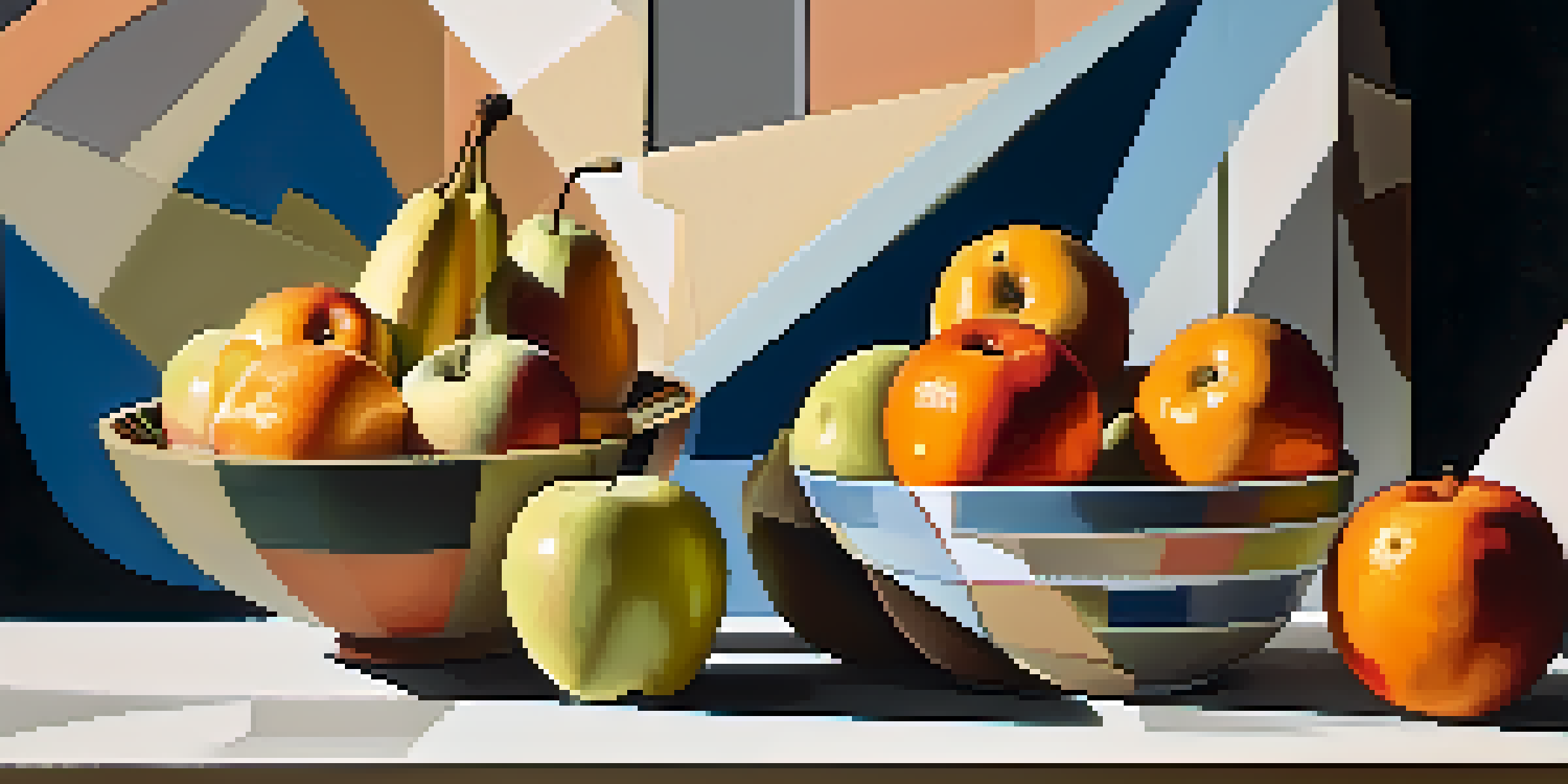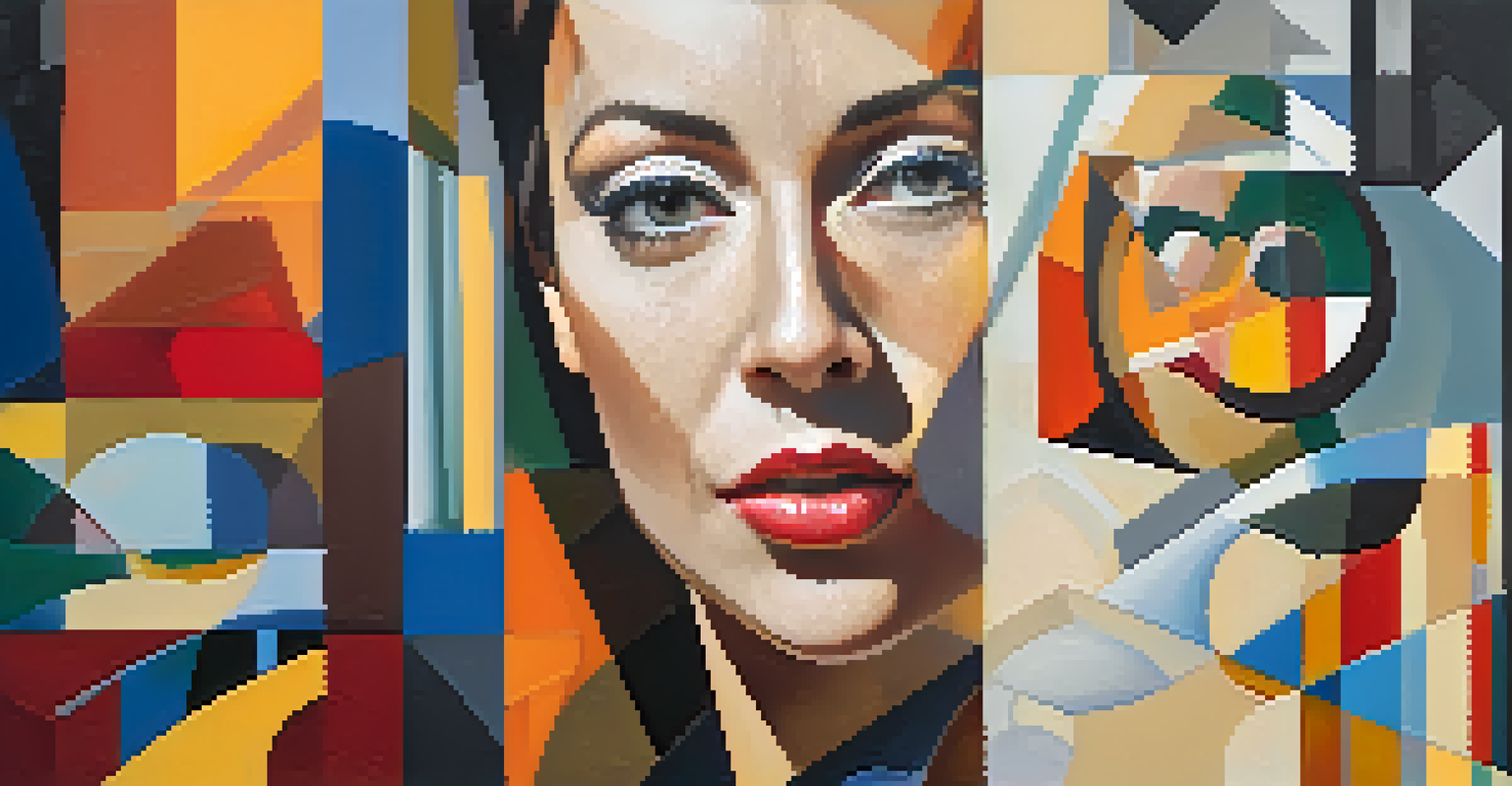Cubism: Breaking Forms and the Manifestos Behind It

Understanding Cubism: The Basics Unveiled
Cubism emerged in the early 20th century, revolutionizing the art world by challenging traditional perspectives. Instead of depicting subjects from a single viewpoint, artists fragmented objects into geometric shapes, offering multiple angles simultaneously. This innovative approach allowed viewers to engage with the artwork in a more dynamic way, much like piecing together a visual puzzle.
Art is a lie that makes us realize the truth.
Pioneered by artists like Pablo Picasso and Georges Braque, Cubism was not merely a style but a radical shift in how art could represent reality. The movement broke away from naturalistic representations, reflecting the complexities of modern life and thought. This shift parallels the way we experience the world today—seeing it through multifaceted lenses that highlight various interpretations.
Ultimately, Cubism set the stage for numerous modern art movements that followed, including Futurism and Surrealism. Its ability to convey depth and form in abstract ways challenged the boundaries of artistic expression, encouraging future artists to explore and experiment. By breaking forms, Cubism opened the door to endless possibilities in visual narrative.
The Birth of Cubism: A Historical Context
Cubism was born in the backdrop of a rapidly changing world, marked by technological advancements and shifting societal norms. The early 1900s were a time of innovation, with the rise of photography and new scientific theories influencing art. This context prompted artists to rethink representation, leading to the development of Cubism as a response to these changes.

The movement's inception can be traced to Picasso's 'Les Demoiselles d'Avignon' in 1907, which presented figures in fragmented forms that defied conventional beauty. This painting shocked audiences and laid the groundwork for Cubism, prompting further exploration of form and perspective. It wasn't just a painting; it was a manifesto of sorts, signaling a new era in art.
Cubism Redefined Artistic Perspectives
Cubism transformed how artists represented reality by breaking objects into geometric shapes and presenting multiple viewpoints simultaneously.
Braque later joined Picasso in refining this style, leading to what is known as Analytical Cubism. This phase focused on breaking down subjects into geometric shapes and muted colors, emphasizing the structure rather than the subject itself. The historical context of industrialization and modernity was pivotal in shaping these ideas, making Cubism a reflection of its time.
Manifestos: Defining Cubism's Philosophical Roots
Manifestos played a crucial role in articulating the principles of Cubism, with the first being penned by Picasso and Braque in 1910. These documents served as both declarations of intent and invitations to explore new artistic territories. They outlined the philosophical underpinnings of Cubism, emphasizing the importance of abstraction and the rejection of traditional aesthetics.
We must kill the picture, the old way of seeing, that we may pass on to the new way of seeing.
The Cubist Manifesto challenged artists to think critically about their work, encouraging them to break free from established norms. It was a call to arms, suggesting that art should reflect the complexities of the human experience rather than merely represent the visible world. This revolutionary spirit resonated beyond art, influencing literature and philosophy of the time.
Additionally, the manifestos emphasized collaboration among artists, fostering a community that shared ideas and techniques. This collective approach not only enriched the movement but also highlighted the importance of dialogue in the creative process. The power of shared vision is evident in how Cubism evolved, continuously reshaping its identity through collaborative efforts.
Key Artists: Figures Behind the Cubist Movement
While Picasso and Braque are the most recognized figures of Cubism, several other artists contributed significantly to the movement. Juan Gris, for instance, brought a distinct flavor to Cubism with his vibrant colors and clear forms, often blending elements of collage into his work. His approach highlighted the versatility of Cubism and its potential for innovation.
Fernand Léger also played a pivotal role, infusing his works with a sense of modernity and mechanical aesthetics. His bold use of color and simplified forms captured the essence of the industrial age, showcasing how Cubism could evolve to reflect contemporary life. Each artist’s unique perspective enriched the movement, allowing it to flourish.
Historical Context Shaped Cubism
Emerging during a time of technological innovation and societal change, Cubism reflected the complexities of modern life and thought.
Moreover, women artists like Sonia Delaunay made significant contributions that are often overlooked. Delaunay’s exploration of color and textile design brought a fresh perspective to Cubism, merging art with everyday life. Her work reinforces the idea that Cubism was not just a male-dominated movement but a platform for diverse voices.
Cubism's Evolution: From Analytical to Synthetic
Cubism underwent a significant transformation, evolving from its initial phase known as Analytical Cubism to what is now called Synthetic Cubism. Analytical Cubism, characterized by its monochromatic palettes and fragmented forms, focused on deconstructing objects into their basic shapes. This phase emphasized the complexity of perception, inviting viewers to reconsider how they engage with art.
As the movement progressed, Synthetic Cubism emerged around 1912, shifting towards a more colorful and decorative approach. Artists began to incorporate different materials and textures, creating collages that blurred the lines between painting and sculpture. This evolution reflects a growing desire to experiment with not just form, but also medium and context.
The transition from Analytical to Synthetic Cubism mirrors broader changes in the art world, where experimentation and innovation became paramount. This shift revealed that Cubism was not a static style but a dynamic movement capable of adapting and influencing various forms of art. It paved the way for future explorations in abstraction and mixed media.
Cubism's Impact: Influencing Modern Art and Beyond
The influence of Cubism extends far beyond its immediate timeline, shaping the trajectory of modern art in profound ways. Its radical approach to form and perspective laid the groundwork for abstraction, inspiring artists like Piet Mondrian and Jackson Pollock. These artists drew upon Cubist principles to further explore the relationship between shape, color, and emotion in their own works.
Furthermore, Cubism's emphasis on fragmentation and multiple viewpoints resonated with movements such as Surrealism and Futurism. Artists began to experiment with new ideas of reality and perception, pushing the boundaries of what art could convey. The legacy of Cubism is evident in how contemporary artists continue to challenge traditional narratives through their work.
Legacy Beyond Visual Arts
Cubism's influence extends into literature, music, and architecture, challenging traditional narratives and inspiring innovation across creative fields.
Beyond visual arts, Cubism's impact can also be felt in literature, music, and architecture. Writers like Gertrude Stein embraced Cubist ideas in their narrative structures, while composers explored dissonance and rhythm in ways that parallel Cubist aesthetics. This multi-disciplinary influence underscores Cubism's role as a catalyst for innovation across creative fields.
Conclusion: The Enduring Legacy of Cubism
Cubism remains a powerful testament to the transformative potential of art. Its ability to break down forms and challenge perceptions has left an indelible mark on the artistic landscape. By encouraging artists to explore abstraction and multiple perspectives, Cubism not only redefined what art could be but also opened doors for future generations.
The manifestos that accompanied the movement serve as reminders of the revolutionary spirit that fueled its emergence. They invite us to reflect on the role of art in society and the importance of questioning established norms. As we continue to navigate a complex world, the lessons from Cubism resonate, urging us to embrace multiplicity and innovation.

In a world that often seeks simplicity, Cubism teaches us to appreciate the beauty of complexity. Its legacy is not just in the artworks it produced, but in the mindset it fostered—a willingness to break forms, challenge conventions, and see the world through a kaleidoscope of perspectives.